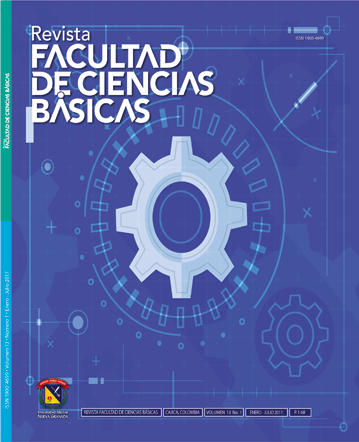Actividad neuroprotectora de Solanum ovalifolium (Solanaceae) contra la toxicidad inducida por rotenona en Drosophila melanogaster
Resumen
Los objetivos de este trabajo fueron evidenciar la presencia de flavonoides en el extracto metanólico de Solanum ovalifolium por cromatografía líquida de alta eficiencia (HPLC-UV), analizar la actividad antioxidante por los métodos de 1,1-difenil-2-picrilhidrazilo (DPPH•) y ácido 2,2'-azinobis-(3-etilbenzotiazolina)-6-sulfónico (ABTS•+), cuantificar el glutatión (GSH), las unidades de enzima antioxidante superóxido dismutasa (SOD) y determinar el efecto neuroprotector contra la toxicidad inducida por rotenona (100 µM) con el modelo in vivo de Drosophila melanogaster mediante geotaxis negativa y cuantificación de la dopamina (DA) de las células cerebrales por (HPLC-UV). A través del perfil fitoquímico por cromatografía líquida de alta eficiencia (HPLC-UV) se evidenció un alto contenido de flavonoides, principalmente dihidroxiflavona (83.33%) y flavona-flavonol (16.66%), el extracto presentó una concentración media inhibitoria para los radicales DPPH• y ABTS•+de 179.8 µg/mL y 34.4 µg/mL respectivamente. En el extracto de S. ovalifolium a 1000 mg/L se cuantificó 4.28 nmol de GSH/ mL de extracto y 1.43 unidades SOD/mL del extracto. En la evaluación del efecto neuroprotector, las moscas macho variedad silvestre (75) co-expuestas a 7 días de tratamiento con el extracto metanólico de S. ovalifolium 0.1% presentaron un menor efecto tóxico y una protección completa contra el estrés oxidativo inducido por rotenona. El contenido de dopamina fue de 61-65 µg/L. Adicionalmente, este trabajo confirma la utilidad del modelo in vivo de D. melanogaster como una etapa en la evaluación de posibles medicamentos neuroprotectores.
Descargas
Referencias bibliográficas
• Bindseil, K. U., Jakupovic, J., Wolf, D., Lavayre, J., Leboul, J., & van der Pyl, D. (2001). Pure compound libraries; a new perspective for natural product based drug discovery. Drug Discovery Today, 6(16), 840-847.
• Bosson, A., Boisseau, S., Buisson, A., Savasta, M., & Albrieux, M. (2015). Disruption of dopaminergic transmission remodels tripartite synapse morphology and astrocytic calcium activity within substantia nigra pars reticulata. Glia, 63(4), 673-683.
• Braga, P. C., Scalzo, R. L., Dal Sasso, M., Lattuada, N., Greco, V., & Fibiani, M. (2016). Characterization and antioxidant activity of semi-purified extracts and pure delphinidin-glycosides from eggplant peel (Solanum melongena L.). Journal of Functional Foods, 20, 411-421.
• Brand-Williams, W., Cuvelier, M.-E., & Berset, C. (1995). Use of a free radical method to evaluate antioxidant activity. LWT-Food Science and Technology, 28(1), 25-30.
• Cárdenas, P., Sonawane, P., Heinig, U., Bocobza, S., Burdman, S., & Aharoni, A. (2015). The bitter side of the nightshades: Genomics drives discovery in Solanaceae steroidal alkaloid metabolism. Phytochemistry, 113, 24-32.
• Correa, Y. M., Mosquera, O. M., & Nino, J. (2011). Evaluation of Colombian Rainforest plants for their DNA interaction and cytotoxic activities. International Journal of PharmTech Research, 3, 632-638.
• Coulom, H., & Birman, S. (2004). Chronic exposure to rotenone models sporadic Parkinson's disease in Drosophila melanogaster. The Journal of Neuroscience, 24(48), 10993-10998.
• Dajas, F., Rivera-Megret, F., Abin-Carriquiry, J. A., Echeverry, C., Lafon, L., Heizen, H., . . . Morqui, A. (2003). Neuroprotection by flavonoids. Brazilian Journal of Medical and Biological Research, 36(12), 1613-1620.
• Diniz, T. C., Silva, J. C., Lima-Saraiva, S. R. G. d., & et al. (2015). The Role of Flavonoids on Oxidative Stress in Epilepsy. Oxidative Medicine and Cellular Longevity, 2015, 9.
• Everett, S. A., Dennis, M. F., Patel, K. B., Maddix, S., Kundu, S. C., & Willson, R. L. (1996). Scavenging of nitrogen dioxide, thiyl, and sulfonyl free radicals by the nutritional antioxidant-carotene. Journal of Biological Chemistry, 271(8), 3988-3994.
• Flagg, R. O. (1988). Carolina Drosophila Manual: Carolina Biological Supply Company Burlington.
• Gargano, J. W., Martin, I., Bhandari, P., & Grotewiel, M. S. (2005). Rapid iterative negative geotaxis (RING): a new method for assessing age-related locomotor decline in Drosophila. Experimental Gerontology, 40(5), 386-395.
• Ghisalberti, E. (1997). Cardiovascular activity of naturally occurring lignans. Phytomedicine, 4(2), 151-166.
• González, M. R., Hernández, R. V., del Tánago, P. G. G., LLerena, A. L., Oliver, D. P., & León, A. C. (2016). Enfermedad de Parkinson. Panorama actual del medicamento, 40(392), 264-281.
• Gracia de Garcia, C. C., Correa, A., & Rojas, C. (1995). Estudio fitoquímico preliminar y evaluación de la actividad antimicrobiana de algunas plantas superiores colombianas. Revista Colomiana de Ciencias Químicas Farmaceúticas (23), 42-48.
• Gutierrez-Merino, C., Lopez-Sanchez, C., Lagoa, R., K Samhan-Arias, A., Bueno, C., & Garcia-Martinez, V. (2011). Neuroprotective actions of flavonoids. Journal of Current Medicinal Chemistry, 18(8), 1195-1212.
• Hosamani, R., & Muralidhara. (2009). Neuroprotective efficacy of Bacopa monnieri against rotenone induced oxidative stress and neurotoxicity in Drosophila melanogaster. NeuroToxicology, 30(6), 977-985.
• Kong, Y., Huang, S., Xie, M., Xue, Y., Zou, K., & Liu, S. (2015). The Antioxidant Activity of Scopolin from Solanum cathayanum to Nerve Cells. Medicinal Plant, 6(1), 1- 8.
• Kumaran, A., & Joel Karunakaran, R. (2007a). In vitro antioxidant activities of methanol extracts of five Phyllanthus species from India. LWT-Food Science and Technology, 40(2), 344-352.
• Kumaran, A., & Joel Karunakaran, R. (2007b). In vitro antioxidant activities of methanol extracts of five Phyllanthuss pecies from India. LWT-Food Science and Technology, 40(2), 344-352.
• Limón, D., Díaz, A., Mendieta, L., Luna, F., Zenteno, E., & Guevara, J. (2010). Los flavonoides: mecanismos de acción, neuroprotección y efectos farmacológicos. Mensaje Bioquímico, 34(1), 143-155.
• Londoño, F., Cardona, W., Alzate, F., Cardona, F., elez, I. D., Upegui, Y., . . . Robledo, S. M. (2016). Antiprotozoal activity and cytotoxicity of extracts from Solanum arboreum and S. ovalifolium (Solanaceae). Journal of Medicinal Plants Research, 10(8), 100-107.
• Martínez S, Bonilla M y López H. (2015). Lista de Orchidaceae de Santander y comentarios sobre sus especies endémicas. Revista Facultad de Ciencias Básicas, 11 (2): 54-111.
• Mattila, P., Astola, J., & Kumpulainen, J. (2000). Determination of flavonoids in plant material by HPLC with diode-array and electro-array detections. Journal of Agricultural and Food Chemistry, 48(12), 5834-5841.
• Mosquera, O. M., Correa, Y. M., Buitrago, D. C., & Niño, J. (2007). Antioxidant activity of twenty five plants from Colombian biodiversity. Memorias do Instituto Oswaldo Cruz, 102(5), 631-634.
• Munari, C. C., de Oliveira, P. F., de Souza Lima, I. M., de Paula Lima Martins, S., de Carvalho da Costa, J., Bastos, J. K., & Tavares, D. C. (2012). Evaluation of cytotoxic, genotoxic and antigenotoxic potential of Solanum lycocarpum fruits glicoalkaloid extract in V79 cells. Food and Chemical Toxicology, 50(10), 3696-3701.
• Ndebia, E., Kamgang, R., & Nkeh-ChungagAnye, B. (2007). Analgesic and anti-inflammatory properties of aqueous extract from leaves of Solanum torvum (Solanaceae). African Journal of Traditional, Complementary and Alternative Medicines, 4(2), 240-244.
• Nguelefack, T. B., Feumebo, C. B., Ateufack, G., Watcho, P., Tatsimo,et al., (2008). Anti-ulcerogenic properties of the aqueous and methanol extracts from the leaves of Solanum torvum Swartz (Solanaceae) in rats. Journal of Ethnopharmacology, 119(1), 135-140.
• Niño, J., Correa, Y., & Mosquera, O. (2006). Antibacterial, antifungal, and cytotoxic activities of 11 Solanaceae plants from Colombian biodiversity. Pharmaceutical Biology, 44(1), 14-18.
• Niño, J., Narváez, D. M., Mosquera, O. M., & Correa, Y. M. (2006). Antibacterial, antifungal and cytotoxic activities of eight Asteraceae and two Rubiaceae plants from Colombian biodiversity. Brazilian Journal of Microbiology, 37(4), 566-570.
• Niño Osorio, J., Morales, P. A., Correa, N., Milena, Y., Mosquera, M., Oscar, M., & Batero, J. (2007). Extractos vegetales con actividad sobre cepas mutadas de Saccharomyces cerevisiae con deficiencia en el mecanismo de reparación del ADN. Scientia et Technica, 1(33).
• Niño, G.E.A., Torrenegra, R.D. (2011). Extracción, Separación e Identificación de la Sustancia Activa Producida por Espeletia killipii como Defensa Ante el Ataque de Larvas de Lepidóptero. Revista Facultad de Ciencias Básicas, 7:126 – 133.
• Parvathaneni, M., Battu, G. R., Gray, A. I., & Gummalla, P. (2014). Investigation of anticancer potential of hypophyllanthin and phyllanthin against breast cancer by in vitro and in vivo methods. Asian Pacific Journal of Tropical Disease, 4, S71-S76.
• Patel, M., Vasaya, M. M., Asker, D., & Parsons, R. B. (2013). HPLC–UV method for measuring nicotinamide N-methyltransferase activity in biological samples: Evidence for substrate inhibition kinetics. Journal of Chromatography B, 921–922(0), 87-95.
• Prakash, A., Satyan, K., Wahi, S., & Singh, R. (1995). Comparative hepatoprotective activity of three Phyllanthus species, P. urinaria, P. niruri and P. simplex, on carbon tetrachloride induced liver injury in the rat. Phytotherapy Research, 9(8), 594-596.
• Prasad, S. N. (2013). Neuroprotective efficacy of eugenol and isoeugenol in acrylamide-Induced neuropathy in rats: Behavioral and biochemical evidence. Neurochemical Research, 38(2), 330-345.
• Re, R., Pellegrini, N., Proteggente, A., Pannala, A., Yang, M., & Rice-Evans, C. (1999). Antioxidant activity applying an improved ABTS radical cation decolorization assay. Free Radical Biology and Medicine, 26(9), 1231-1237.
• Rubin, G. M., Yandell, M. D., Wortman, J. R., Gabor, G. L., Nelson, C. R., et al., (2000). Comparative genomics of the eukaryotes. Science, 287(5461), 2204-2215.
• Ruiz-Martínez, J., Ascacio, J., Rodríguez, R., Morales, D., & Aguilar, C. (2011). Phytochemical screening of extracts from some Mexican plants used in traditional medicine. Journal of Medicinal Plants Research, 5(13), 2791-2797.
• Rumbaoa, R. G. O., Cornago, D. F., & Geronimo, I. M. (2009). Phenolic content and antioxidant capacity of Philippine potato (Solanum tuberosum) tubers. Journal of Food Composition and Analysis, 22(6), 546-550.
• Sabir, S. M., & Rocha, J. B. T. (2008). Antioxidant and hepatoprotective activity of aqueous extract of Solanum fastigiatum (false “Jurubeba”) against paracetamol-induced liver damage in mice. Journal of Ethnopharmacology, 120(2), 226-232.
• Samarth, R. M., Panwar, M., Kumar, M., Soni, A., Kumar, M., & Kumar, A. (2008). Evaluation of antioxidant and radical-scavenging activities of certain radioprotective plant extracts. Food Chemistry, 106(2), 868-873.
• Sánchez-Lamar, A., Fuentes, J. L. s., Fonseca, G., Cápiro, N., Ferrer, M., Alonzo, A., . . . Llagostera, M. (2002). Assessment of the potential genotoxic risk of Phyllantus orbicularis HBK aqueous extract using in vitro and in vivo assays. Toxicology Letters, 136(2), 87-96.
• Siqueira, S., Falcão-Silva, V. d. S., Agra, M. d. F., Dariva, C., Siqueira-Júnior, J. P. d., & Fonseca, M. J. V. (2011). Biological activities of Solanum paludosum Moric. extracts obtained by maceration and supercritical fluid extraction. The Journal of Supercritical Fluids, 58(3), 391-397.
• Uversky, V. N. (2004). Neurotoxicant-induced animal models of Parkinson’s disease: understanding the role of rotenone, maneb and paraquat in neurodegeneration. Cell and Tissue Research, 318(1), 225-241.
• Valcarcel, J., Reilly, K., Gaffney, M., & O’Brien, N. M. (2015). Antioxidant activity, total phenolic and total flavonoid content in sixty varieties of potato (Solanum tuberosum L.) grown in Ireland. Potato Research, 58(3), 221-244.
• Veličković, D., Stankov-Jovanović, V., Mitić, V., Kostić, D., & Palić, R. (2013). Antimicrobial and antioxidant activities of essential oil and crude extracts of Hypericum tetrapterum Fries (Hypericaceae). Journal of Medicinal Plants Research, 4(14), 1441-1445.
• Wagner, H., & Bladt, S. (1996). Plant drug analysis: a thin layer chromatography atlas: Springer Science & Business Media.
• Wink, M. (2003). Evolution of secondary metabolites from an ecological and molecular phylogenetic perspective. Phytochemistry, 64(1), 3-19.
• Yang, W.-M., Liu, J.-K., Qin, X.-D., Wu, W.-L., & Chen, Z.-H. (2004). Antioxidant activities of three dihydrochalcone glucosides from leaves of Lithocarpus pachyphyllus. Zeitschrift für Naturforschung. C, Journal of Biosciences, 481-484.












